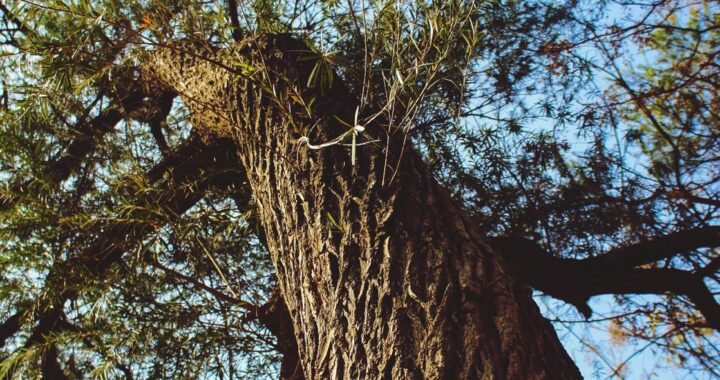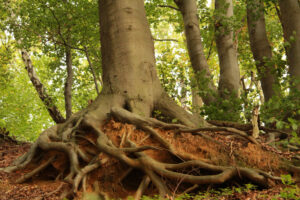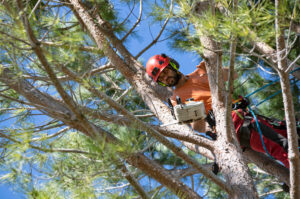Trimming tall trees can enhance safety and promote healthy growth, but also carries risks. In this guide, we’ll walk you through how to trim tall trees safely, what tools you need, the best timing, and when to call in the pros.
Should You Trim Tall Trees Yourself?
Trimming tall trees on your own can be doable, but only under the right conditions.
✔️ When DIY is doable (and when it’s not)
Homeowners can safely trim the tree if branches are under 20 ft, not near power lines, and you have proper tools and footing. Skip DIY if climbing is needed or the tree is close to structures.
✔️ Height limits and tools
Over 20–25 ft? Call a pro. For smaller jobs, use a pole pruner, pruning saw, and a stable ladder. Always wear gloves, a helmet, and eye protection.
✔️ Common risks
DIY trimming can lead to:
- Falling limbs
- Bad cuts that harm the tree
- Ladder accidents
- Electrocution if near power lines
When safety is in doubt, hire a certified arborist.
What Happens If You Don’t Trim Overgrown Trees?
Skipping regular trimming can lead to more than just an unkempt yard. Overgrown trees can cause serious damage over time, both above and below ground.
Root damage risks
When a tree’s canopy grows too large, its root system expands to support it. This can lead to roots cracking driveways, lifting sidewalks, or damaging underground pipes and foundations.
Interference with power lines
Branches that grow into utility lines pose fire hazards, power outages, and potential legal issues. Most utility companies require clearance and may fine homeowners who ignore it.
Disease or pest exposure
Dense, overcrowded limbs block airflow and sunlight, creating ideal conditions for fungi, mold, and pests like carpenter ants or beetles.
Property safety concerns
Untrimmed trees are more likely to drop heavy limbs during storms or high winds, which can damage roofs, cars, fences, or injure someone.
Tools You’ll Need to Trim a Tall Tree
✅ Pole saw or extendable pruner
✅ Hard hat, gloves, and safety glasses
✅ Ladder with stabilizer (or lift equipment)
✅ Safety harness or climbing gear (if climbing is needed)
✅ Optional: Rope and pulley to control falling branches
Step-by-Step: How to Trim a Tree That’s Too Tall
Step 1: Inspect the Tree
Identify dead, damaged, or weak branches, these are priority cuts for safety and health.
Step 2: Choose your target limbs
Select branches based on safety, growth direction, and structure. Avoid topping, which can harm the tree long-term.
Step 3: Plan your method
Begin from the ground. Before climbing or using extended tools, ensure clear surroundings, stable footing, and tools within reach.
Step 4: Trim from bottom to top
Removing lower limbs first improves visibility and balance while working upward.
Step 5: Make clean, angled cuts
Cut just outside the branch collar, not flush to the trunk, to ensure proper healing and reduce disease risk.
Step 6: Don’t overdo it
Never remove more than 25% of the tree’s canopy at once. Removing too much foliage stresses the tree and can trigger weak, structural regrowth known as epicormic shoots.
Step 7: Clean as you go
Clear branches and debris regularly to avoid accidents and keep your workspace safe.
What NOT to Do When Trimming a Tall Tree
Trimming a tree the wrong way can do more harm than good. One of the biggest mistakes is topping, cutting off the top of the tree to reduce height. This weakens the structure and leads to unpredictable, unhealthy regrowth.
Never use a chainsaw on a ladder, as it’s one of the most dangerous combinations in DIY tree work. If the job requires that level of reach, it’s time to call a pro.
Also, avoid trimming near power lines without contacting your utility company first. Working too close can cause serious injury or outages.
Finally, don’t remove the central leader, especially in conifers like pines and spruces. This vertical stem guides healthy upward growth, and cutting it can permanently distort the tree’s shape.
Timing: When Is Best to Trim Tall Trees?
The optimal time to prune most deciduous trees is late winter to early spring (mid‑February through May), when they’re still dormant and wounds heal faster before new growth begins. Light pruning of dead or damaged branches can be done year‑round, especially for safety or cleanup after storms. Avoid major trimming in late summer or fall; removing green wood at that time stresses the tree and increases disease vulnerability.
DIY vs Professional Tree Trimming — What’s Right for You?
| Aspect | DIY Tree Trimming | Professional Service |
| Best For | Small to medium trees, light shaping | Very tall trees, structural pruning, or risk removal |
| Tree Type Guidelines | Fruit trees, ornamental trees, young maples | Mature oaks, pines, spruces, large hardwoods |
| When to Trim | Late winter to early spring (before new growth) | Same seasonal window, with expert timing per species |
| Signs It’s Time | Dead branches, uneven growth, rubbing limbs | Overcrowding, storm damage, branches near utilities |
| Cost | Low (tools + your time) | Higher, but includes gear, cleanup, and safety |
| Risk Level | Medium to high (especially above 15–20 ft) | Low — licensed, insured, and trained crews |
| Tools Needed | Pruner, pole saw, ladder | Lift, rigging gear, harnesses, chainsaws |
| Time Commitment | 2–5 hours depending on size | 1–3 hours with a full crew |
When to Call a Tree Trimming Pro Instead
If your tree is too tall to trim safely from the ground (or you’re simply not comfortable taking it on), calling a pro is often the smartest move. Professionals like Chris Lane Enterprises that offer tree services have the right gear, training, and crew to handle the job efficiently without risking injury or damage. Their team can assess the health of your tree, trim it to industry standards, and take care of clean-up and disposal so you don’t have to.
Let Chris Lane Enterprises take the weight off your shoulders. Request your tree trimming quote today.
FAQs
What to do when a tree gets too tall?
Inspect the tree for dead or weak branches. If those limbs are out of safe reach, consider hiring professional tree services from Chris Lane Enterprises.
What part of a tree should not be cut?
Avoid removing the central leader in conifers or topping the tree’s crown.
How do you shorten a tree without killing it?
Use structured pruning, removing < 25% of live canopy and cutting outside the branch collar.
How to cut tree limbs that are too high to reach?
Use pole saws from the ground, or hire professionals with lifts or crane access for tall or complex trees.



